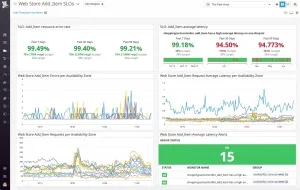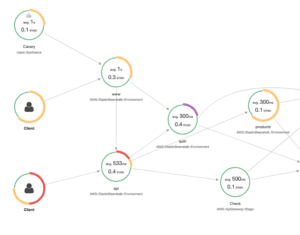Datadog and Amazon CloudWatch both perform advanced application performance monitoring (APM). Both offer broad monitoring and data analytics. Yet there are as many differences between them as similarities.
Application performance management (APM) refers to the management of software performance as a means of ensuring that the expected level of service is being provided.
APM takes advantage of a variety of performance metrics such as throughput, IO, and various user experience parameters. The goal is to pinpoint performance issues before users notice that anything is wrong. IT can then fix the issue before user calls inundate the Help Desk.
APM software makes it possible for IT to observe application behavior, understand infrastructure dependencies, and correlate this with the user experience and compare to key performance indicators (KPIs).
Core APM capabilities include: automated discovery and mapping of applications and related components; observation of transactional behavior; monitoring mobile and browser-based applications; investigation of performance problems; integration with other enterprise applications; analysis of KPIs, times of login and logout; integration with data from third-party sources; and visibility across end users, applications, networks, and the cloud.
Buyers looking for an application performance monitoring platform may find both Datadog and CloudWatch on their list of candidates. Overall, though, they’re very different applications that will likely appeal to buyers with different goals in mind. Here’s a look at Datadog and CloudWatch, how they compare, and their ideal use cases.
Also see: Real Time Data Management Trends
Datadog vs. CloudWatch: Feature Comparison
Datadog APM provides end-to-end distributed tracing from front-end devices to databases with no need for sampling. By correlating distributed traces between front-end and back-end data, it enables IT to monitor service dependencies, reduce latency, and eliminate errors.
Datadog offers APM, log management, and related monitoring delivered as SaaS deployments. As such, it collects, prepares, and presents telemetry data from logs and various metrics, providing context to reduce incident response time.
Datadog focuses on cloud monitoring and security. It offers the ability to see inside any stack or application at any scale and anywhere. Infrastructure monitoring, APM, log management, device monitoring, cloud workload monitoring, and database monitoring fall within its feature set. But Datadog stops short of calling itself a complete Security Information & Event Management (SIEM), IT service management (ITSM), or IT operations management (ITOM) platform.
Amazon CloudWatch monitors Amazon Web Services (AWS) resources and applications in real time. It can be used to collect and track metrics, with the CloudWatch home page automatically displaying metrics about every AWS service used.
Cloudwatch can create custom dashboards to display metrics about custom applications and display custom collections. Alarms can be tied to metrics with automatic notifications triggered or even automatically make changes to resources being monitoring when a threshold is breached. For example, CPU usage and disk reads and writes of Amazon EC2 instances can be tracked to determine whether to launch additional instances to handle increased load. It also spots under-used instances to save money. Overall, CloudWatch offers system-wide visibility into resource utilization, application performance, and operational health.
But CloudWatch is restricted to the AWS platform. For heavy users of AWS, it is clearly a top choice. But outside of that use case, Datadog wins due to the width of application areas it monitors.
The Datadog application.
Datadog vs. CloudWatch: Comparing Implementation and Ease of Use
Datadog installation and commissioning are said by users to be straightforward via the deployment of agents. Some command line scripting is required. Users can get up and running fast. And it is easy to customize dashboards and interfaces. The main interface covers a lot of ground. It’s great for experienced users, but it might be tough for new users, who may be overwhelmed by the number of options. But overall, the Datadog dashboards and interface are self-explanatory.
CloudWatch, though, is less straightforward. Veteran AWS professionals won’t find it challenging. But others might. Applications can’t just be viewed directly from the dashboard, for example. Some searching is needed to find what you are looking for. For ease of use, Datadog wins.
Also see: What is Data Visualization
The Cloudwatch application.
Datadog vs. CloudWatch: Comparing Support and Integration
Datadog can work with numerous data sources and formats, but it is not a platform that is set up to deal with a comprehensive number of information sources. Data formats like .xml, .csv, and .json are not supported, for example. That said, Datadog can integrate well with other security and IT management tools. Datadog supports community APIs and extensions to integrate it into existing IT infrastructure. It is available for Windows, Mac, and Linux. Datadog is also happy to integrate with other security and IT management tools. This includes AWS, Azure, and other platforms.
CloudWatch supports and can integrate with anything within AWS. It supports any and all data sources, formats, and integrations within the many flavors of AWS. Further, it supports real-time data, which Datadog does not. But it doesn’t integrate with non-AWS application data to incorporate it into monitoring.
In this category, Datadog wins, though it must be acknowledged that Cloudwatch covers the AWS user.
Datadog vs. CloudWatch: Security Comparison
A few years ago, you could provide APM tools and software without needing to be too concerned about the vast number of cybersecurity challenges. Yet that is a thing of the past. Most vendors now have to take care of security as a core aspect of application development – or face serious repercussions.
Similarly, in APM, vendors now have to ensure they are providing a safe environment for users. Being a SaaS application, Datadog has had to up its game on security. It has been steadily adding security features in recent years, including a security analysis tool.
Cloud security in CloudWatch is good. AWS is of course responsible for protecting the infrastructure that runs AWS services in the AWS Cloud. AWS also provides you with services that you can use securely. There are clear demarcation lines between Amazon and its customers in terms of who handles what. CloudWatch comes out slightly ahead on security.
Also see: What Does 2022 Hold for Intelligent Automation
Datadog vs. CloudWatch: Management Comparison
Datadog offers management and monitoring across a narrow sphere of the overall enterprise market. It does particularly well with regard to APM and cloud services. This includes good drill down and general management capabilities.
Further, Datadog manages itself well, generating alerts about potential or actual problems within itself and helping IT to identify the underlying issues. Yet autoscaling of applications can be challenging.
However, report preparation and creation can be cumbersome in Datadog with limited reporting options. Amazon CloudWatch far exceeds Datadog on reporting due to the number of metrics freely available and the ease of report collation. But CloudWatch is unable to group servers and visualize them in a customized fashion, whereas Datadog groups, visualizes and customizes server views. CloudWatch is also far better at auto-scaling applications as well as raising database capacities.
Overall, CloudWatch gets the nod with the caveat that it is limited to the AWS universe.
Datadog vs. CloudWatch: Price Comparison
Datadog prices out at around $15 per user per month, roughly, and it is $23 for the Enterprise version. Datadog has an open pricing policy with published prices, and generally low prices. Its pricing per-month options include per-host, per million events, and per GB of analyzed log files. But Gartner noted that some large deals entail large upfront spending. According to the analyst firm, this can lead to over- and under-provisioning.
You can get started with Amazon CloudWatch for free. Most AWS Services (EC2, S3, Kinesis, etc.) send metrics automatically for free to CloudWatch. Many applications should be able to operate within these free tier limits. But those using it extensively or with their infrastructure built around AWS should expect to pay substantially.
Cloudwatch pricing is based on the number of custom metrics, with no API charge for sending metrics. The number of metrics sent by an EC2 instance is dependent on the instance type. Typically, EC2 Detailed Monitoring is charged at $2.10 per instance per month (assumes 7 metrics per instance) and goes down to $0.14 per instance at the lowest priced tier.
In the pricing category, CloudWatch wins.
Also see: Top Edge Companies
Datadog vs. CloudWatch: Conclusion
Amazon CloudWatch and Datadog are both excellent applications designed to solve a great many challenges related to security and performance monitoring. You can’t go too far wrong with either one. Both are strong in APM. Both also offer a lot of advanced features for your money that go far beyond APM. And both are trailblazers when it comes to innovation and future roadmaps.
Datadog takes an infrastructure monitoring approach geared toward analytics and application performance. It is focused on performance measurement for cloud services and is particularly adept at measuring the performance of databases and servers as well as measuring performance in a multi-cloud world. Since Datadog is aimed at monitoring infrastructure at scale, it’s used primarily by mid-sized companies and large enterprises. It is also favored by DevOps and IT to address cloud and infrastructure performance.
CloudWatch is restricted to the AWS world. Therefore, those within that sphere would clearly adopt it. But for anyone else, Datadog wins.
Also see: Tech Predictions for 2022: Cloud, Data, Cybersecurity, AI and More

